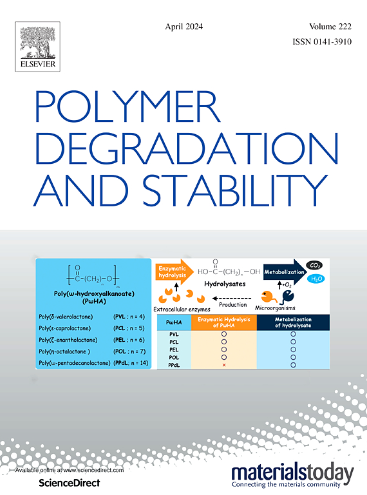Polyphenylene sulfide alloying and carbon fiber reinforcing together promote polycarbonate towards superior flame retardant composite with good mechanics
IF 7.4
2区 化学
Q1 POLYMER SCIENCE
引用次数: 0
Abstract
Advanced composite technology is the motive force to develop of high-performance composite materials, which includes the superior flame retardant composite materials with superior physical and mechanical properties. This work reports the flame retardant behavior and mechanism of short-cut carbon fiber (SCF) and polyphenylene sulfide (PPS) in polycarbonate (PC) matrix, so as to their influence on material mechanics. Individually adding SCF already presented visible effectiveness on suppressing PC combustibility. 6SCF/PC achieved a limited oxygen index (LOI) of 30.0 %, and passed UL94 V-0 rating at 3.2 mm thickness. But when the thickness of specimen reduced to 1.6 mm thickness, 6SCF/PC only passed UL94 V-2 rating. The failure of SCF in shortening self-extinguishing time and anti-dripping was overcome by extra introducing PPS to work together with SCF. 20PPS/6SCF/PC passed UL94 V-1 rating at 1.6 thickness, and achieved a LOI of 33.0 %. Meanwhile, the flame retardant mechanism of SCF and PPS in suppressing PC combustibility was investigated from the charring behavior, the thermal decomposition process and volatile release, and the pyrolytic products of relevant composites. Besides, the additive effect of SCF and PPS in improving the char residue retention and flexural stiffness of composites was also confirmed. Polyphenylene sulfide alloying and carbon fiber reinforcing together promote polycarbonate towards superior flame retardant composite with good mechanics.

聚苯硫醚合金化和碳纤维增强共同促进聚碳酸酯向性能优良的阻燃复合材料发展
先进的复合技术是高性能复合材料发展的动力,高性能复合材料包括具有优异物理力学性能的阻燃复合材料。本文报道了短段碳纤维(SCF)和聚苯硫醚(PPS)在聚碳酸酯(PC)基体中的阻燃行为和阻燃机理,以及它们对材料力学的影响。单独添加SCF在抑制PC可燃性方面已经表现出明显的效果。6SCF/PC实现了30.0%的限氧指数(LOI),并在3.2 mm厚度下通过了UL94 V-0等级。但当试样厚度减小到1.6 mm时,6SCF/PC仅通过UL94 V-2额定值。通过额外引入PPS与自熄液协同工作,克服了自熄液在缩短自熄时间和防滴水方面的不足。20PPS/6SCF/PC在1.6厚度下通过UL94 V-1额定值,LOI达到33.0%。同时,从SCF和PPS的炭化行为、热分解过程和挥发性释放以及相关复合材料的热解产物等方面研究了SCF和PPS抑制PC可燃性的阻燃机理。此外,还证实了SCF和PPS在改善炭渣保留率和复合材料抗弯刚度方面的加性作用。聚苯硫醚合金化和碳纤维增强共同促进聚碳酸酯向性能优良的阻燃复合材料发展。
本文章由计算机程序翻译,如有差异,请以英文原文为准。
求助全文
约1分钟内获得全文
求助全文
来源期刊

Polymer Degradation and Stability
化学-高分子科学
CiteScore
10.10
自引率
10.20%
发文量
325
审稿时长
23 days
期刊介绍:
Polymer Degradation and Stability deals with the degradation reactions and their control which are a major preoccupation of practitioners of the many and diverse aspects of modern polymer technology.
Deteriorative reactions occur during processing, when polymers are subjected to heat, oxygen and mechanical stress, and during the useful life of the materials when oxygen and sunlight are the most important degradative agencies. In more specialised applications, degradation may be induced by high energy radiation, ozone, atmospheric pollutants, mechanical stress, biological action, hydrolysis and many other influences. The mechanisms of these reactions and stabilisation processes must be understood if the technology and application of polymers are to continue to advance. The reporting of investigations of this kind is therefore a major function of this journal.
However there are also new developments in polymer technology in which degradation processes find positive applications. For example, photodegradable plastics are now available, the recycling of polymeric products will become increasingly important, degradation and combustion studies are involved in the definition of the fire hazards which are associated with polymeric materials and the microelectronics industry is vitally dependent upon polymer degradation in the manufacture of its circuitry. Polymer properties may also be improved by processes like curing and grafting, the chemistry of which can be closely related to that which causes physical deterioration in other circumstances.
 求助内容:
求助内容: 应助结果提醒方式:
应助结果提醒方式:


